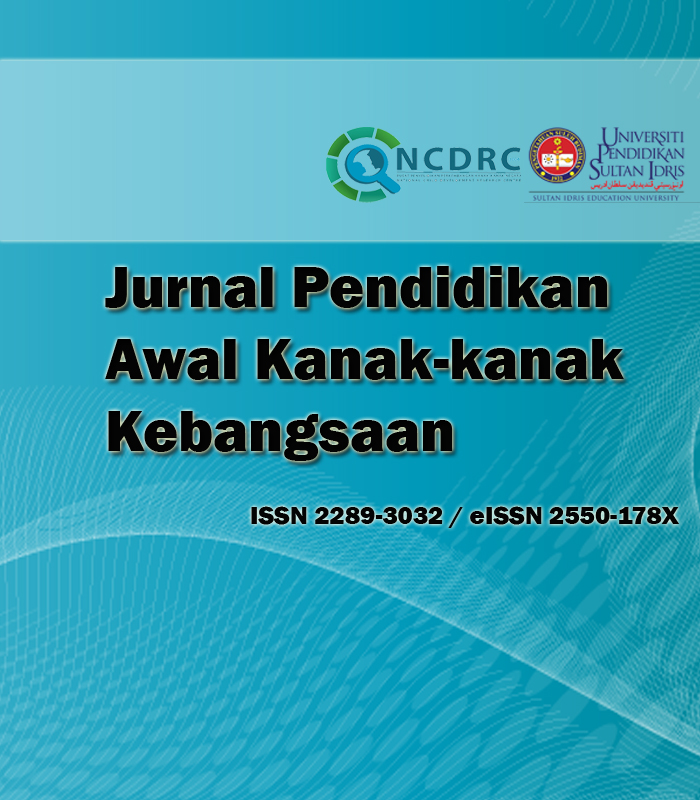Indikator sokongan pembelajaran dalam reka bentuk flipped classroom bagi murid bermasalah pembelajaran berdasarkan kesepakatan pakar
Learning support indicators in flipped classroom design for student with learning disabilities based on expert agreement
DOI:
https://doi.org/10.37134/jpak.vol9.2.3.2020Keywords:
kesepakatan pakar, murid bermasalah pembelajaran, flipped classroom, reka bentuk, sokongan pembelajaran, indikator, expert agreement, student with learning disabilities, design, learning support, indicator, fuzzy delphiAbstract
Kini, pendekatan pengajaran dan pembelajaran secara dalam talian semakin diperkukuhkan. Namun, tahap aksesibiliti Murid Bermasalah Pembelajaran (MBP) untuk mendapatkan maklumat pembelajaran melalui Flipped Classroom masih lagi terhad. Maka, kajian ini bertujuan untuk mengetahui tentang indikator sokongan pembelajaran serta item utama yang diperlukan dalam reka bentuk Flipped Classroom bagi MBP berdasarkan kesepakatan pakar. Secara khusus, kajian yang dijalankan ini menggunakan kaedah kuantitatif dengan teknik Fuzzy Delphi. Seramai 11 orang pakar dalam bidang pendidikan khas serta reka bentuk dan teknologi terlibat dalam kajian ini. Dapatan menunjukkan sebanyak 11 item dalam indikator sokongan pembelajaran telah dipersetujui oleh pakar dan peratus kesepakatan adalah melebihi 75%. Dari segi keutamaan, item “Audio yang jelas.” memperoleh kedudukan tertinggi dengan nilai 0.897, manakala “Penggunaan ayat secara berstruktur.” memperoleh nilai terendah iaitu 0.767. Ini menunjukkan penggunaan audio yang jelas dapat menggantikan mesej berbentuk ayat kepada MBP. Penemuan ini dapat dijadikan panduan kepada guru dalam reka bentuk bahan pengajaran menggunakan Flipped Classroom serta memudahkan aksesibiliti murid MBP semasa menggunakan Flipped Classroom.
Today, online teaching and learning approaches are increasingly being strengthened. However, the level of accessibility of Students with Learning Disabilities (SLD) to obtain learning information through Flipped Classroom is still limited. Thus, this study aims to find out about learning support indicators as well as key items needed in the design of Flipped Classroom for SLD based on expert agreement. Specifically, this study uses quantitative methods with Fuzzy Delphi technique. A total of 11 experts in the field of special education as well as design and technology were involved in this study. Findings show that 11 items in the learning support indicators have been agreed by experts and the percentage of agreement is more than 75%. In terms of priority, the item "Clear audio" obtained the highest position with a value of 0.897 while "Structured sentence usage" obtained the lowest value of 0.767. This shows that the use of clear audio can replace sentence-shaped messages to SLD. This finding can be used as a guide for teachers in the design of teaching materials using Flipped Classroom as well as facilitate the accessibility of SLD while using Flipped Classroom.
Downloads
References
Abeysekera, L., & Dawson, P. (2015). Motivation and cognitive load in the flipped classroom: Definition, rationale and call for research. Higher Education Research & Development, 34(1), 1–14.
Adler, M. & Ziglio, E. (1996). Gazing into the oracle the delphi method and its application to social policy and public health. Jessica Kingsley Publisher.
Al-Ibrahim, A. (2019). Deaf and hard of hearing students' perceptions of the flipped classroom strategy in an undergraduate education course. European Journal of Educational Research, 8(1), 325-336.
Al-Zain, H. (2015). The effect of using the flipped learning strategy on the academic achievement of the students in the education department in princess nourah bint abdulrahman university. International Specialized Journal of Education, 4(1), 16.
Bahagian Pendidikan Khas. (2015). Maklumat pendidikan khas. Kementerian Pendidikan Malaysia.
Bahagian Pendidikan Khas. (2019). Enrolmen murid berkeperluan khas. Kementerian Pendidikan Malaysia.
Bergmann, J., & Sams, A. (2008). Remixing chemistry class: Two colorado teachers make vodcasts of their lectures to free up class time for hands-on activities. Learning & Leading with Technology, 36(4), 22-27.
Center for Applied Special Technology. (2011). Universal design for learning. http://www.cast.org/impact/universal-design-for-learning-udl.
Cisarova, K., Lamr, M. & Vitvarova, J. (2015). Advanced learning space as an asset for students with disabilities. TOJET: The Turkish Online Journal of Educational Technology, 14 (2): 1-13.
Duboff, R. & Spaeth, J. (2000). Market research masters: Tools and technique for aligning your bussiness. Wiley.
Eshak, Z., & Zain, A. (2020). Kaedah fuzzy delphi: Reka bentuk pembangunan modul seksualiti pekasa berasaskan latihan mempertahankan diri untuk prasekolah. Jurnal Pendidikan Awal Kanak-kanak Kebangsaan, 9(2), 12-22.
Findlay-Thompson, S., & Mombourquette, P. (2014). Evaluation of a flipped classroom in an undergraduate business course. Business Education and Accreditation, 6(1), 63-71.
Fives, C. J. (2008). Vocational assessment of secondary students with disabilities and the school psychologist. Psychology in the School 45(6), 508-519.
Hartley, J. (2013). Designing instructional text. RoutledgeFalmer.
Ibrahim, R., Yasin, M. H. M., & Abdullah, N.(2016). Pemilihan bidang pendidikan bagi murid berkeperluan khas bermasalah pembelajaran (Education choice among student with learning disabilities). Journal of Advanced Research in Social and Behavioural Sciences. 3(2), 152-161.
Jamil, M. R. M., Said, S., & Azeez, M. I. K. (2017). Kompetensi guru terhadap pengurusan pengajaran dan pembelajaran: Suatu pendekatan teknik fuzzy delphi. JuPiDi: Jurnal Kepimpinan Pendidikan, 1(3), 77-88.
Lee, M. F., & Lai, C. S. (2016). Rhetoric value based model for Malaysian special vocational education secondary schools’ teachers. Journal of Advanced Research in Social and Behavioural Sciences, 2, 1-6.
Lichtinger, E., & Kaplan, A. (2015). Employing a case study approach to capture motivation and self-regulation of young students with learning disabilities in authentic educational contexts. Metacognition and Learning, 10(1), 119-149.
Mohd Najib (1999). Penyelidikan pendidikan. Penerbitan Universiti Teknologi Malaysia
Mohd Redhuan, M. J., Saedah, S., Zaharah, H., Nurulrabihah, M. N. & Ahmad, A. S. (2014). Pengenalan asas kaedah fuzzy delphi dalam penyelidikan reka bentuk pembangunan. Minda Intelek.
Ramli, M. F., & Musa, R. (2020). Ekplorasi seni visual melalui aktiviti lakaran asas terhadap kanak-kanak prasekolah. Jurnal Pendidikan Awal Kanak-Kanak Kebangsaan, 9(1), 35-47.
Rosen, D. J. (2013). Career exploration: Web-based videos. Journal of Research and Practice for Adult Literacy, Secondary, and Basic Education, 2(1), 58-60.
Siti Nurul, M.M., Sazilah, S. & Norasiken, B. (2014). Online Multiple Intelligence Teaching Tools (On-MITT) for educators. International Journal of Multidisciplinary Education and Research 1(2), 38-41.
Sue, R. & Round, A. (2013). Supporting persons with disabilities in postsecondary education and life-long learning. Journal of Vocational Rehabilitation, 22, 1-2.
Sunarti, S., & Rachman, D. (2018). The effectiveness of flip classroom with student teams-achievement divisions (stad) method to teach reading viewed from students’ english learning interest. Script Journal: Journal of Linguistics and English Teaching, 3(2), 183-194.
Tu, H.-W., & Liu, Y.-H. (2016). Understand the flipped classroom: A reflection. International Journal of Arts & Sciences, 9(2), 249-256.
Vaughan, M. (2014). Flipping the learning: An investigation into the use of the flipped classroom approach in an introductory teaching course. Education Research and Perspectives, 41, 25-41.





